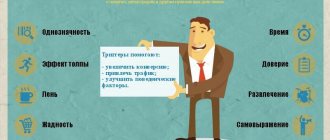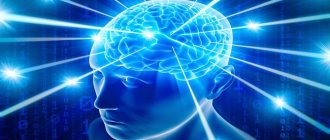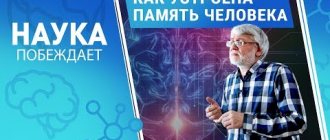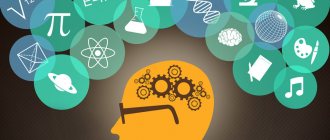For many years, debates have continued in psychology about the importance of mechanical memory in human life. Some consider it to be too primitive a form, working within the framework of the first signaling system (which is also present in some animals). Others are inclined to consider it the basis without which it would be difficult to master certain types of material that is not subject to logic and comprehension. One way or another, without it, it really can be difficult at certain moments, and therefore its development should be given no less attention than all other types of memory.
Mechanical memory
The main difference between this type of memory is the learning of any information only in the form in which it is presented. Mechanical memory is based on the neural connections of the first signaling system. When a person studies information that is expressed in words, then the words themselves will remain in the head, exactly as they were perceived. If we are talking about physical exercises, then a person will remember the movements themselves that he needs to repeat, and only in the sequence in which they were visually perceived. In this case, the logical or semantic content of the material fades into the background, but, of course, does not lose its meaning. The volume of mechanical memory is inexhaustible.
We wish you a phenomenal memory!
We are training
When you are going to the store, write down what you need to buy. Read it out loud several times. To repeat, you can, for example, imagine a school board and write on it what you need to buy and in what quantity. Now go to the store, and don't forget to leave the list at home!
Whether you're standing in line or waiting for someone, don't get bored. Mentally draw, as if in a sketchbook with a pencil, letters, numbers, geometric shapes. Try to feel the movement of your hand, even though it should remain motionless.
On your way to work, count in your head, gradually increasing the digits of the numbers. Calculate the Fibonacci sequence, in which each next number is the sum of the two previous ones: 1 + 1 = 2, 1 + 2 = 3, 2 + 3 = 5, 3 + 5 = 8, etc. In the advertising text, first count all the letters “ a", then "b" and further alphabetically.
Remember in every detail your yesterday, your last vacation or an interesting event. Recall from memory the content of a movie you watched or a book you read. Now “turn back time”: remember all this in reverse order.
At work, open your desk drawer and look at its contents for 20 seconds. Try to remember at least 10 items. Close the drawer and try to remember what is in it and in what order. Open it and check it.
Now take a close look at the items on your colleague’s desk. Turn away and ask him to rearrange them. (Tell him that this is useful, because the habit “dries out” the brain.) Turn around and try to name everything that has changed. Such exercises develop attentiveness and visual memory.
To develop auditory memory, ask ten words to be read aloud to you and try to reproduce them in the same order from memory. Learn to distinguish people's voices and recognize them from memory. For example, when talking on the phone with your partner, imagine him. If you hear several voices from the meeting room, try to find out who each of them belongs to without looking.
Pleasant smells come from the kitchen or cafe. Try to guess what they are cooking there. And when you are treated to a meal, blindfold yourself before the dish is served, and try to determine by taste and smell what you are being fed. This way you will develop your taste and olfactory memory. To develop tactile memory, try to determine by touch the denomination of coins, the type of fabric, and so on.
When does mechanical memory work best?
Of course, this method of memorization, especially in schools or universities, is not an indicator of the level of knowledge. However, it also has its positive sides. For example, if you are learning a foreign language, you must remember not only how new words are pronounced, but also how they are written. This cannot be done unless you concentrate on learning them in precise visual and auditory images. When mastering difficult professional terms, it is mechanical memory that is involved, otherwise the latter are remembered and reproduced with errors and speech distortions. Also, mechanical memory works when familiarizing yourself with simple physical exercises in physical education classes or in gyms.
The positive result of memorizing this or that material using rote memory is based on fixing certain connections between parts of the information being studied according to the principle of associations.
However, it is not enough just to memorize the necessary information in its external manifestation; it is important to be able to retain it in memory for a long time. This is accomplished due to the great plasticity of the nervous system. And after just a couple of repetitions, strong connections are formed and consolidated in the head. This is most often observed in those who have truly outstanding mechanical memory. If a person does not have such abilities, the necessary information can be learned through repeated repetition, due to which weak nerve connections become stronger, the necessary paths between certain parts of the cerebral cortex, which are important in remembering the information received, are repeated.
How does rote learning of material occur?
The main technique of rote memory is learning by repeatedly reading, watching or repeating certain elements. These manipulations are very primitive, their essence lies in one hundred percent repetition of the same material in the images of the first signal system, which helps to firmly consolidate the nerve connections.
As for studies, material learned mechanically is reproduced only in expressions and actions originally taken as a basis, without any deviations. If mistakes were made during training, they will be repeated when reproducing the material.
The same applies to movements: a memorized physical exercise or a simple dance will be reproduced in exactly the same form in which it was presented. If, when repeating movements or material, conditions other than those used during memorization are created, the mechanically memorized exercise will be repeated with difficulty, since it will be quite difficult for a person to adapt to the changes. For this reason, the exercise cannot be repeated exactly as it was learned.
Use Cicero's method
This method continues the technique of creating associations and is suitable when you need to remember a daily routine, a piece of text, a list of phone calls - any sequence.
The Roman orator Cicero, who is famous for his speeches, did not use notes when speaking to the public. He reproduced historical dates, names and quotes from memory. The following method helped him in this: the speaker mentally arranged the units that needed to be remembered in a well-known room in a certain order. During his speech, Cicero imagined the room and easily remembered the necessary names and dates.
The method is also called the place method or the Roman room method.
Example:
You need to remember the sequence of words: puppy, cheese, ruler, plasticine, puddle. Mentally, you imagine your room, in which you know every detail, and walk through it, sorting through the objects one by one:
“There is a puppy sitting in front of the room. I go inside and to the left of the door I see a chest of drawers with a cheese sandwich on it. I pass by the chest of drawers and see a desk, and on it there is a yellow ruler, it immediately catches my eye. I move on, approach the window and see a plasticine figure on the windowsill. Turning it over in my hands, I head to the exit of the room and pass by a sofa, the wooden legs of which are swollen from water, as it is standing in a puddle.”
Logical memory
The main difference between logical memory and mechanical memory is that it is aimed to a greater extent not at memorization, but at the concept of the meaning of the information received. Logical memory is based on the work of thinking. In order for information to be logically memorized, it is first analyzed, broken down into components, which are divided into important and not very important.
Logical memory is the result of mental work, which finds its expression in the form of words, diagrams, drawings, and so on, reflecting in the human mind primarily the meaning of what is being studied, and not visual or auditory manifestations.
Differences between logical memory and mechanical memory
First of all, these are the features of reproduction: logical memory manifests itself in the form of an independently meaningful presentation, while mechanical memory manifests itself in the form of an accurate repetition of information.
Logical memory has many components; it should not only be a superficial analysis of the material, but also its understanding, comprehension and reproduction in verbal form. Logical memory, just like mechanical memory, needs repetition of the information provided. Without regularly returning to the information received, knowledge will not be 100% consolidated in memory.
Another significant difference is that with rote memory, repetition is aimed at remembering the same connections, which are unchanged. That is why the same text or movement is reproduced with each repetition. For example, schoolchildren memorize poems in a clearly established sequence. It is a mechanical memory which in any other case will not achieve its purpose.
When memorizing logically, a person tries to understand the meaning of the information being studied, which with each new repetition may differ from the previous one. The meaning remains the same, but it can be expressed in a new way each time. Logical and mechanical memory are very different in the methods of study.
Memory, its main types and their characteristics. Theories of memory in psychology
- home
- State exam in the specialty Psychology of Personality (bachelor's degree)
- General psychology
->
->
1. General characteristics of memory
2. Types of memory
3.Theories of memory in psychology.
Memory is a mental process that manifests itself in a person’s ability to retain his past experiences, and also allows him to re-apply them in his life and activities. Memory is a trace mental reflection of the past. It allows you to combine the present, past and future into a single process. It is thanks to memory that a person assimilates the experience of previous generations, acquires new knowledge, skills and abilities (Kozubovsky, V.M. General psychology: cognitive processes: textbook)
Thanks to memory, a person realizes the unity of the past and the present, the integrity of the human “I” is preserved. Without a certain amount of memory, mental activity, imagination, the creation of images, and orientation in the environment in general are impossible.
The basic processes of memory are the storage, recognition, forgetting and reproduction of information. Recognition is a simpler process compared to reproduction. It occurs in the presence of an object, while reproduction occurs in its absence.
The more complex nature of reproduction is also demonstrated by the ontogenetic development of memory - recognition of people and objects is already noticed in 4-month-old children, and reproduction - in 9-month-olds.
consolidation, preservation and reproduction of traces of received impressions.
2. Types of memory and brief description
Types of memory are classified according to the following criteria: the degree of awareness of the memorized information (images), the nature of mental activity, the duration of storage of images, the goals of the study, the nature of the connection with the goals of the activity
The nature of mental activity depends on what types of analyzers, sensory systems and subcortical formations of the brain are included in memory processes. Based on this, memory is distinguished: figurative, motor, emotional, verbal-logical.
Figurative memory is the memorization, preservation and reproduction of images of previously perceived objects and phenomena of reality. There are subtypes of figurative memory: visual (visual), auditory (sound, auditory), gustatory, olfactory; tactile.
Motor (also known as motor) memory is the ability to remember, retain and reproduce various characteristics of movement, their amplitude, speed, pace, rhythm, sequence (riding a bicycle, swimming, playing volleyball, etc.).
Emotional memory is memory for. Emotional states experienced and stored in memory act as signals either prompting action or restraining from actions that caused negative experiences in the past.
Verbal-logical (semantic) memory is expressed in remembering and reproducing our thoughts. We remember and reproduce the thoughts that arose in us during the process of thinking, reflecting, and we remember the contents of the book we read.
Based on the degree of participation of thinking, this type of memory is divided into mechanical and logical.
Memory is called mechanical in the case when memorization and storage of information occurs primarily through repeated repetition without understanding its content.
With age, such memory tends to deteriorate. An example of mechanical memory would be “forced” memorization of words that are not related in meaning.
Unlike mechanical memory, logical memory is based on the use of semantic connections between memorized objects, phenomena or subjects.
Based on the degree of awareness of the information being remembered, implicit and explicit types of memory are also distinguished.
Implicit memory is memory for material that a person is not aware of. The process of memorization occurs in this case independently of consciousness, implicitly, and therefore inaccessible to direct observation. Such memory requires a kind of “launch”, and such a starter may be the need to solve some problem that is important for a given moment. At the same time, a person is not aware of the knowledge that he possesses.
For example, during the process of socialization, a person perceives the values and norms of society without being aware of the basic theoretical principles that underlie his behavior. This happens to him as if by itself.
Explicit memory, on the contrary, is based on a person’s conscious application of previously acquired knowledge. And when solving any problem, this knowledge is extracted from consciousness on the basis of recognition, recall, etc.
There is also a division of memory into types, which is directly related to the characteristics of the activity being performed. Thus, depending on the goals of the activity, memory is divided into involuntary and voluntary.
Involuntary memory is memorization and reproduction that occurs automatically, without volitional efforts of a person, without control by consciousness. In childhood, this type of memory is more developed, but weakens with age.
Voluntary memory requires the volitional efforts of a person and the purpose of memorization and is carried out using special techniques.
For example, memorizing poetry. Or a police officer memorizing external signs in the guise of a wanted criminal in order to identify him upon meeting and arrest him. It should be noted that comparing the characteristics of voluntary and involuntary types of memory in terms of the strength of memorizing information does not give absolute advantages to any of them.
Based on the duration of storage of images, human memory is divided into instantaneous (sensory), short-term, operational and long-term memory.
Finally, depending on the purposes of the study, memory is divided into genetic (biological), episodic, reconstructive, reproductive, associative, autobiographical. Genetic (biological) memory is memory for biological events of the huge evolutionary period of man as a species.
It is determined by the mechanism of heredity and preserves a person’s tendency to patterns of action and certain types of behavior in specific situations. It is through genetic memory that instincts, elementary innate reflexes and even elements of a person’s physical appearance are transmitted. Episodic memory stores individual fragments of information with a fixation of the situation in which it was perceived (place, time, method
Reproductive memory is the repeated reproduction by recalling a previously stored original object. Reconstructive memory consists not so much in the reproduction of an object, but in the restoration of a disrupted sequence of stimuli in its original form. Associative memory is based on any established functional connections (associations) between memorized objects. Autobiographical memory is the memory of events in one's own life.
3.Theories of memory in psychology. Associative theory of memory by G. Ebbinghaus
The theory of memory, which formed the basis of the first classical experimental studies of G. Ebbinghaus and his successors (G.E. Müller, A. Pilzecker, F. Schumann, etc.), was entirely built on the doctrine of associations.
The essential thing in this theory is that the fact of external contiguity of impressions in itself is recognized as sufficient for establishing a connection between ideas and for their reproduction.
Based on this, Ebbinghaus built his entire research. He used series of nonsense syllables consisting of three letters (one vowel placed between two consonants, for example tug-fal-dor-seth), with all those combinations that produced any meaningful word turned off. In the selection of such material, Ebbinghaus was guided by the desire to obtain homogeneous material and create uniform conditions for various subjects. The absence of meaningful content in the memorized material and semantic connections in it was unimportant for Ebbinghaus, because for him the process of reproduction was determined by the fact of the external contiguity of the memorized material creating associative connections.
About this classical theory, which attempted to reduce memory to associative connections alone, the following must be said: associative connections undoubtedly play a significant role, especially in elementary forms of memory; however, the work of memory in general, especially the higher forms of memory in humans, is not reducible to associations alone and cannot be fully explained by the associative theory.
A comparison of the results of learning nonsense syllables and meaningful words, then individual meaningful words and words combined into meaningful sentences of a connected text, showed that memory performance is directly dependent on the presence of semantic connections that unite the memorized material into more or less extensive semantic wholes.
The dependence of reproduction on semantic content was identified in the work of A.G. Comm with a special experimental technique, which consisted in the fact that the subjects were asked to reproduce the same material according to a different plan. It turned out that with a change in the interpretation and general plan of the story, the selection of reproduced details also changes: with one plan and one interpretation, some parts are reproduced and dropped out, with a different plan and another interpretation, other parts.
The concept of memory by A. Binet and K. Bühler
The concept presented by A. Binet and K. Bühler brings semantic content to the fore, relying on the indisputable fact that memorizing semantic content does not mechanically coincide with memorizing the speech form in which it is given.
Research (by A. Binet, K. Bühler and a number of others) clearly revealed the role of comprehension in memorization and showed that meaningful memorization is subject to different laws than mechanical reproduction based on contiguity associations. When reproducing a meaningful text, its main, most meaningful parts are reproduced much better; For the most part, what is secondary and unimportant is forgotten. The unimportant is thus eliminated; parts that are significant in meaning are, as it were, isolated from parts adjacent to them, but essentially unrelated in meaning to them, uniting in memory with those with which they are connected by the semantic context. Thus, instead of mechanical reproduction of adjacent parts, which should have taken place according to the laws of association, in fact, when memorizing and reproducing a meaningful text, a much more complex process of semantic selection occurs, as a result of which the most essential for a given subject, the main semantic framework of the text, is predominantly consolidated. The text itself undergoes a more or less significant reconstruction. Reproduction in these cases is not determined by contiguity, but can be accomplished despite contiguity connections, in accordance with semantic connections.
Representatives of this direction are trying to turn memory into the reproduction of pure thoughts, not at all dependent on any speech form. Since they tear apart and outwardly oppose each other between the memorization of thoughts and the memorization of words, they inevitably come to conclusions that converge with the seemingly antagonistic theory of Ebbinghaus, in which the semantic content, although with an opposite tendency, is also torn away from the verbal text.
Activity theory of memory
In modern science, a theory that, as a basic concept, considers the activity of an individual as a factor that determines the formation of all its mental processes, including memory processes, is gaining increasing recognition. According to this concept, the course of the processes of memorization, preservation and reproduction is determined by the place this material occupies in the subject’s activity.
Among the general laws that express the significance of semantic connections and play a significant role in the work of memory, one should also include what can be called the functional principle in the work of memory. It plays a particularly significant role in the process of recall.
Numerous observations that we have accumulated in this direction and which anyone can easily make, encourage us to consider all these facts as a manifestation of a general pattern and put forward the functional principle or the law of reproduction according to a functional characteristic as one of the general laws of memory.
This functional principle, in particular, apparently explains one also everyday and yet seemingly paradoxical fact: we often remember that we don’t remember something; when remembering something forgotten, if we turn up something that is not what we were trying to remember, we immediately realize or feel: no, this is not it. Thus, we know that we have forgotten, although it would seem that, since we have forgotten, we do not know it. In fact, in these cases we usually have some functional knowledge about the connections in which what we have forgotten is located. When remembering, we very often look for the bearer of certain, more or less clearly realized functions and connections. In the process of remembering, we start from them, and when we seem to remember something forgotten, we check whether we have remembered what we wanted to remember by how what has emerged in memory is included in these connections. By identifying what has surfaced in memory with what we are looking for or rejecting it as not what we wanted to remember, we are largely based on some semantic context from which the recollection comes.
Memory from the point of view of Gestalt therapy
A set of facts indicating the role of structural unification of material in the process of memorization was used by Gestalt psychology. Its representatives tried to turn structure into the same universal principle that association was for supporters of the associative theory. Structuring is recognized as the only and universal basis of memory.
The main concept of Gestalt psychology is the concept of Gestalt (from German Gestalt - image), which means an initially holistic structure. Mental activity is characterized by a desire for integrity and completeness. In accordance with this, the organization of material is recognized here as the basis for the formation of connections, which determines a similar structure of memory traces in the brain according to the principle of isomorphism, i.e. similar in form. In Gestalt psychology, the principle of integrity appears as initially given, and the laws of Gestalt (like the laws of associations) act outside and apart from the will and consciousness of the person himself.
The desire of mental activity for completion is also manifested in the fact that an unfinished action, an unfulfilled intention leaves a trace in the form of tension in the mental system. This tension tends to be discharged (real or symbolic). A consequence of persistent tension is, for example, the effect of unfinished action, which consists in the fact that the content of an unfinished action is remembered by a person better than the content of a completed one. The lack of integrity and completeness not only generates tension, but also contributes to internal conflicts and neuroses.
The basic principle of the theory of memory, according to Gestalt, is that the analysis of individual elements of an association cannot lead to an understanding of the whole, since the whole is determined not by the sum, but by the interdependence of its individual parts. A separate part is only a part and does not give any idea of the whole.
Thus, all the diverse activities of memory are again reduced to one form. Instead of a universal law of association, Gestaltists try to establish a universal principle of structure.
BIOCHEMICAL THEORIES OF MEMORY
These theories suggest the formation of new protein substances (neuropeptides and others) during long-term memory.
First, immediately after exposure to the stimulus, an electrochemical reaction occurs in the nerve cells, causing reversible physiological changes in the cells (short-term memory), and then, on its basis, the actual biochemical reaction occurs with structural changes in the neuron, providing long-term memory (two-stage nature of the memorization mechanism). Evidence has been obtained experimentally about the important role of ribonucleic acid (RNA) and oligopeptides in the memory function.
The most exciting experiments in recent years have been attempts to transfer memory from one animal to another (“memory transplantation”). If you teach a planaria (flatworm) that light always precedes current, and then kill it and feed it to another planaria, it turns out that the experience acquired by the first planaria is partially transferred to the second worm. The planarian is a relatively primitive organism, and it may have special learning mechanisms that have no bearing on understanding memory in higher organisms. However, there is evidence of the success of a similar experiment on mice and rats - a “memory transfer” of developed conditioned reflexes from one individual to another was carried out using injections of brain homogenate from a previously trained donor animal.
NEURAL AND PHYSICAL-CHEMICAL THEORIES OF MEMORY
There are many theories that support the view of structural or chemical changes in the brain itself as it accumulates information during life.
Memorization and learning are closely related. Even the simplest forms of learning are based on the fact that some event is remembered. Neuroscientists now know three main types of learning:
1) addiction, or habituation (the body stops responding to a frequently occurring stimulus);
2) sensitization (the occurrence of a reaction to a previously neutral stimulus);
3) classical or Pavlovian conditioning.
All characteristics of the temporary nerve connections formed, and above all the degree of strength, are determined by the nature of the reinforcement, which is a measure of the vital (biological) feasibility of a particular action. It is also likely that the passage of any nerve impulse through a group of neurons leaves behind a literal physical trace. The physical materialization of the trace is expressed in electrical and chemical-mechanical changes in synapses, which facilitate the secondary passage of impulses along a familiar path. The simplest neural circuit that provides memory can be represented as a closed loop - the excitation goes through the entire circle and begins a new one. This process of long-term circulation of impulses in neural circuits is called reverberation.
The concept of cycles of neural activity is considered by many to be the material substrate of memory. There are a huge number of neural ensembles (each about 100-300 cells). Each of them stores information about some memory object in the form of a stable wave pattern. The more brain neurons are involved in the rhythms of some pulsating ensemble, the higher the likelihood of awareness of the corresponding image.
Not all memory units are involved and updated at the same time, but only a small number of them. This number serves as a measure of attention span. Due to cyclical fluctuations in the excitability of neural ensembles, images of long-term memory, including images of remembered and spoken words, are not updated all at once, but in turn, some more often, others less often. If the moments of actualization of different images coincide, then such memory units have a chance to unite. Thus, a new concept is developed. This is how learning occurs and acts of creativity are realized.
Activity theory of memory - French scientists, including P. Janet, founded a new theory of memory, based on considering it as a type of activity. P. Janet is one of the scientists who was one of the first to interpret memory as a system of actions that are focused on remembering, systematizing and storing information. The French school of psychology proved the social conditioning of all memory processes, its direct dependence on human activity.
Domestic psychologists, among whom can be named L. Vygotsky, P. I. Zinchenko, A. N. Leontiev, A. A. Smirnov, etc., continued work on the theory in the study of memory related to the general psychological theory of activity.
Memory from the point of view of Gestalt therapy - Representatives of Gestalt psychology (V. Köhler, K. Koffka, M. Wertheimer, K. Levin, etc.)
BIOCHEMICAL THEORIES OF MEMORY. The first hypotheses linking the imprinting of information with biochemical changes in nervous tissue were born on the basis of those widely known in the 60s. experiments by G. Hiden, which showed that the formation of memory traces is accompanied by changes in the properties of RNA and protein in neurons. It turned out that irritation of a nerve cell increases its RNA content and leaves long-lasting biochemical traces that give the cell the ability to resonate in response to repeated actions of the same stimuli. Thus, it was found that RNA plays an important role in the mechanisms of formation and storage of memory traces. However, in later works it was shown that DNA plays a leading role in the consolidation of memory engrams, which can serve as a repository of not only genetic but also acquired information, and RNA ensures the transmission of a specific information code.
R.I. Kruglikov (1986) developed a concept according to which long-term memory is based on complex structural-chemical transformations at the systemic and cellular levels of the brain. At the same time, the cholinergic system of the brain provides the information component of the learning process. Monoaminoergic systems of the brain are more associated with providing reinforcing and motivational components of learning and memory processes.
NEURAL AND PHYSICAL-CHEMICAL THEORIES OF MEMORY.
D. McConnell, (1962) attempts to transfer memory from one animal to another (“memory transplant”). If you teach a planaria (flatworm) that light always precedes current, and then kill it and feed it to another planaria, it turns out that the experience acquired by the first planaria is partially transferred to the second worm.
However, in 1966, J. Ungar conducted experiments on memory transfer in rats and mice. These animals have an instinct to prefer dark corners to open spaces. For 9 days, the rats received an electric shock every time they ran into a dark box. Quite quickly they developed a real fear of dark places. Then, untrained mice were injected with brain homogenate taken from trained rats, after which their reaction to darkness was tested. It took 1-2 days for the injected mice to suppress their dark preference instinct—a remarkable result considering that it takes longer to suppress this instinct in uninjected mice than in rats.
The first studies devoted to the search for the memory center in the brain were undertaken in the 20s by Lashley.
He destroyed various parts of the brain in rats and then tested their retention of acquired skills. He found that even the removal of 15-20% of the brain matter does not lead to the loss of traces acquired during the learning process. Lashley concluded that memory traces are diffusely distributed in the central nervous system in different parts of the brain.
In the late 50s, Penfield observed patients who had undergone various brain surgeries. It is known that when various areas of the cortex are irritated, simple auditory or visual sensations can occur. Penfield made the discovery that when certain areas of the brain are exposed, memories can emerge, sometimes very complex ones. These may be memories of events that the patient has long forgotten. At the end of the operation, these memories remained in memory.
Observations led to the assumption that the “memory center” may be the hippocampus, a formation belonging to the limbic system and located in the temporal lobe of the brain.
Psychoanalytic theory
Representatives of the psychoanalytic theory of memory, the founder of which is S. Freud, pay special attention to the unconscious level of the psyche when considering the preservation and memorization of information.
The psychoanalytic theory of memory shows the significant role played by early emotional experiences that can influence the rest of life. Representatives of this theory pay special attention to the displacement of negative information from consciousness and its manifestation through humor, dreams, slips of the tongue and other manifestations of the unconscious. Thanks to psychoanalysis, many interesting psychological mechanisms of subconscious forgetting related to the functioning of motivation have been discovered and described Arthur Minimulin
Productivity
Logical memory is much more productive than mechanical memory. The explanation for this fact is simple - logical memory is based on numerous and diverse connections. It has been scientifically proven that information that remains in the head through logical memorization is retained much better than exactly the same information, but learned through rote memory.
This is interesting: as practice shows, material that was learned using logical memory can be retained for life, without subsequent repetitions. But mechanically learned information is forgotten very quickly; remains in the head for a long time only with regular repetitions. The study of logical and mechanical memory continues to this day, because the capabilities of the brain have not yet been 100% explored.
Books on mnemonics
Nowadays, a large amount of literature has been written that helps to master this memorization technique. You need to choose the one that will be optimal for your mindset and abilities. Mnemonics for beginners can be studied in the following books:
- “Super Memory” by T. Buzan;
- “Einstein Walks on the Moon” by J. Foer;
- “How to develop super memory?” D. O'Brien;
- “Phenomenal memory” S. Matveev;
- “Remember everything. A practical guide to memory development” A. Dumchev.
Interesting facts about memory
Thanks to memory, a person uses experience every day: his own and his ancestors. However, logical and mechanical memory are complex mechanisms that have their own nuances.
- A person begins to use memory already in the womb; it begins to work 20 weeks after conception. The embryo even reacts to the noise of the ultrasound test. Scientists are of the opinion that a person can remember everything that happened to him not only in childhood, but even in the womb.
- Memory is individual, as it is influenced by many factors. For example, some have better developed visual memory, others have better auditory memory. Information that is interesting to a person is remembered best. But the ability to remember can always be trained.
- Age does not always mean memory decline. You can often hear complaints about poor memory from older people. But this is not entirely true, the whole point is that by adulthood a person stops learning, the skill of straining his memory disappears, and it does not train at all. For example, actors who have spent their entire lives learning new roles can cope with voluminous texts in their old age without any problems. This once again proves that memory development depends only on training, and not on age.
- The habit of forgetting is also present in humans. After all, it is impossible to remember everything, and the ability to forget is a real salvation for the human brain. Memory itself regulates the load, freeing the head from unnecessary information or impressions. But this does not mean at all that old information is completely erased; the data simply moves from the active stage to the passive stage, from where, if desired, it can be retrieved.
Memory can always be improved by training, taking vitamins and eating right.
Training and development
From two to five years of age, a child has a fertile period for improving mechanical memory. During this period of time, it is necessary to read good children's poems to him and teach them together.
Important! You can improve your mechanical memory by mastering foreign languages and memorizing poetic texts. You need to memorize formulas and scientific terms, historical dates and statistical data, product lists, telephone numbers and addresses, geographical names, numbers, first names and patronymics.
Scientists have proven that a person forgets the most information in the first 2 hours after cramming. If you study before bed, much less material will be erased from memory, since during the night's rest it moves from short-term to long-term memory and is then easier to reproduce.
Mechanical memory, according to experts, is the basis for successful learning.
Interest in studying
Exercises for children
- Cascade. An adult reads a list of words. If the child repeats easily, the list increases by one more.
- The parent slowly sounds out 10 words. Children draw them with their fingers on the table, then remember them.
- The child carefully examines the surroundings, then turns away and lists the objects.
- An adult draws a simple composition of figures or a pattern on a sheet of paper. Children watch for one minute, then reproduce it from memory in their notebooks.
- Several different objects or pictures are placed on the table surface. The child looks carefully, then turns away. An adult changes something in the position or completely confuses it. The children's task is to put everything in its place.
- The teacher reads the words, inviting the children to illustrate them using poses, sounds or gestures, then the children try to remember the list.
Repeat text
For an adult, working with text memorization will help increase the volume of mechanical memory. To begin with, you can choose a short passage and try to retell it. Over time, you need to repeat the entire passage, then take 2 texts, increasing the number of characters.
Remembering names
The volume of a person's short-term memory is strongly related to mechanical capabilities. The name of the person just introduced is forgotten because the communication process replaces old information in short-term memory with new information. To remember the name of a friend, you need to pronounce it loudly and clearly, think about how it is similar to its owner.
You can develop mechanical memory more effectively if you follow simple rules:
- Do not take too much information at once, learn in parts;
- Repeat the material at regular intervals;
- Use mnemonics;
- After an hour of work, rest for 15 minutes;
- Diversify the material.











